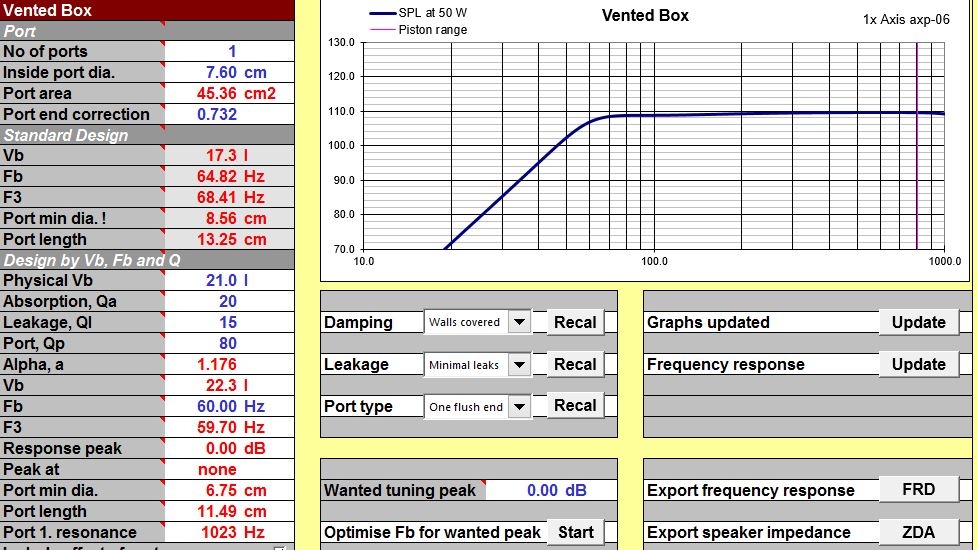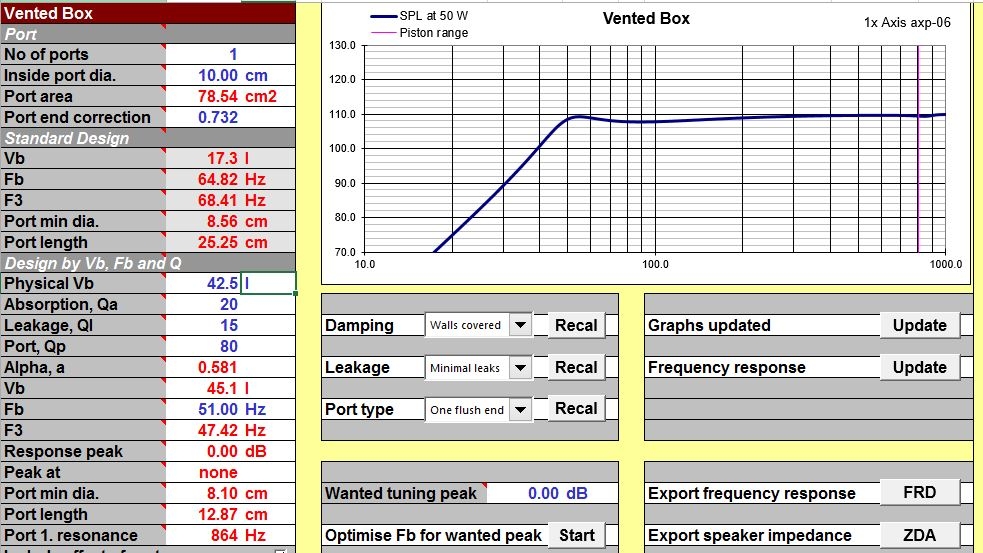Site Links
Howdy, Stranger!
It looks like you're new here. If you want to get involved, click one of these buttons!
Quick Links
Categories
In this Discussion
Who's Online (0)
MCM closeout build
I've about half a dozen of the MCM closeout Axis axp-06, also have a couple xt25tg30-4's laying around. Playing around with unibox says (trying to learn so I may be wrong on this, I won't be offended if you correct me), they'd like to have a 21l.(.75ft³) enclosure, but F³ is 60hz. I'd like to build a two-way (florstander or bookshelf) and move that at least into the high 40 region. Is that going to be doable with this woofer, or should I stick with the smaller box and go the sub/sat route?
The axp also has a rather large hump starting ~1300hz and a bunch of squiggly lines after that so I'm thinking the xt25 isn't going to want to cross that low. How about the the dx25tg59 ($20), dx25bg60 ($35 and out of stock), or dx20bf00 ($12)? Other affordable tweets that go low???
https://www.gradient-acoustics.com/Products/Gradient-Axis/_71105_H12-AXP-06_581007,en,7600,156435 .


The axp also has a rather large hump starting ~1300hz and a bunch of squiggly lines after that so I'm thinking the xt25 isn't going to want to cross that low. How about the the dx25tg59 ($20), dx25bg60 ($35 and out of stock), or dx20bf00 ($12)? Other affordable tweets that go low???
https://www.gradient-acoustics.com/Products/Gradient-Axis/_71105_H12-AXP-06_581007,en,7600,156435 .


Comments
Based on that FR graph I'd think you could bend down the response and get an x-o close to 2,500.
I like the dx20 above about 2K.
I'm not certain 50W will get you 110dB.... nor will it be likely that it can handle that output very well. With a rough estimate of an 88dB/8 ohm midbass, it takes about 64W to get to that level. If using BSC, it's then -6dB from there, so that's closer to 356W to achieve that output.
Alright, scratch some of that- I see it's 93.5dB, estimating at 93dB. You still likely have BSC losses to deal with making it 88dB below around 1k, making it about 64W to achieve that output.
I see you have your port large enough to handle it. I try and shoot for a 100dB output range as a best fit before port chuffing or Xmax et al become issues.
Those 1.5ft^3 boxes are a pretty large floor stander for a 6" 2-way...
Enough of my rambling...
Good luck!
InDIYana Event Website
Also a contender for price ($26), efficiency, and low f³.
Maybe more but I only found 2 kits; one with their gam100 and the other with a horn tweeter.
Will the dx20 be able to keep up?
Wolf, as long as it can get to the upper 90's I'm good. There are more of them sitting in the shed so dual woofers, even 3 per side, aren't out of the question. Yes, that would be a large box for a two way.
Now that I've slept on it, me thinks you're spot on. This is an efficient midrange, it was not intended as a woofer. This should be a sub/sat or 3-way, anything else would be working against the grain.
On that note, I'm tired trying to move ginormous speakers around the room, so a sub/sat might be physically better for my back, but what are going to be the advantages of a 3-way vs sub/sat?
Even more importantly, I'm wanting to learn how and make my own passive crossover for this. I'm sure a 3-way is going to add more complexity ... guess I've gotta' start somewhere.
So, next I need to figure out which tweeter and get that and all the stuff needed to build the arta box (I think it will work with rew) so I can measure impedance. Then figure out why pcd never works right on my windoz8 laptop.
Guys, keep me headed in the right direction.
A 2-way is a great place to start when designing your own passive x-o.
IMO a 3-way avoids imaging/ localizing problems if your satellite doesn't reach low enough. Anything with an F3 the 50's would be fine imo. Subwoofer design is where most people start.
The advantage of sub sat is you can position the sub independent of the sat to counter room modes and you can do 2.1, 2.2 or 2.8.... there is no limit and if you are able to control each sub independently esp with DSP...
One that rolls off easy so it will be easier for me to crossover, plays good up to ~300, will keep up with the mid, affordable, and sounds good.
Is an OB out of the question?
InDIYana Event Website
In as small as .26ft³ sealed, the axp-06 has a qtc. of .69 and f³ of 118hz (with heavy stuffing). Since the mid will play easily into the range of the sub either vented, or sealed, and in a fairly small volume, is there any reason I would want to go vented?
Generally speaking, a cast frame 6" with sizable magnet will consume roughly .3ft³ of cabinet volume?
Is this the correct sub Dayton sd215a-88 dvc #295-484? Never considered this one, had been looking at some of the grs offerings.
In as small as .26ft³ sealed, the axp-06 has a qtc. of .69 and f³ of 118hz (with heavy stuffing). Since the mid will play easily into the range of the sub either vented, or sealed, and in a fairly small volume, is there any reason I would want to go vented?
Generally speaking, a cast frame 6" with sizable magnet will consume roughly .3ft³ of cabinet volume?
Is this the correct sub Dayton sd215a-88 dvc #295-484? Never considered this one, had been looking at some of the grs offerings.
Yep- that's the one!
InDIYana Event Website
I also suk at Sketchup, other than that ... comments???
Going to a side mounted woofer narrows the front baffle. Personally, I think it looks better, and with all other things being equal, isn't a narrower baffle supposed to paint the soundstage better?
What are the pros and cons of a front vs side woofer going to be?
Waiting on PE to put some drivers on sale ...
You can look at a tapered baffle, will also present varrying boundary to the mid/tweet.
But side also works.... Just a few more things to keep in mind and take care of.
Is it ok to use NPE's in the woofer section?
Can I get rid of this peak (@~700hz) with a notch filter? I've used the notch calculator in pcd (4.68 ohm, 170uf, .31mh) but where and how is the data entered? I though if it's supposed to be used in the passband it went in series after the crossover? If it goes in the fields circled, it won't let me enter anything.
It seemed to take a lot to get the area around 4-7k knocked down.
No bsc, just working on the mid/tweet right now, will add the woofer (and bsc) later when, or if, I get a clue to what I'm doing.
How/where is data entered for a notch filter in the passband? That 700hz hump doesn't want to go away.
axp-06 3rd@15oo and nd25ta 2nd@2400. Are those areas too high? Best way to lower them?
axp-06 4th@1500 bc25sc08 3rd@2400
Haven't been able to figure out how to tweak things other than crossover points, slopes, and combinations of them, but tweaking I've been. Sooner or later I'll get there.
Comments please ...
Played around with this one late last night.
axp-06/SB19st-c0004
I would suggest adding baffle step to the raw FRDs with the Blender to get more accurate inductor sizing.
Still have an 'ARTA' impedance box to build (I think it also works with REW) so I can get .frd and .zma files with drivers in place.
When using the frd/.zma of mounted drivers, should baffle step be added in the .frd/.zma before loading into winpcd, or is it added in while building the crossover?
If you guys have good links on the subject, send them, I'm all ears.
Making sawdust. Man it's cold out!
Typically you add in the baffle to the nearfield response to be able to get a good match when using the Blender.
If you want, after you get the box build we could set a time and I'll measure them with you.
Wasted most of today with pcd and the minidsp. The plan was to use the raw driver frd/zma files (rs225p, rs150p, xt25tg) for the, 'not a khanspire ...' build to learn more on how things work in pcd and then apply that to the minidsp to improve their sound, only working on the mid/tweet handoff.
Didn't work.
Whenever there was a 20db dip where they met, they never summed right. When they summed right, there wasn't a 20db dip when one polarity was reversed.
Tried a notch filter to kill a breakup? above the mid's crossover point. Put it in there alright, was able to move it around, but never able to widen it enough to do any good.
On to the minidsp.
Same thing, whenever there was a nice 20db dip, they never summed right. Bet I adjusted and measured a hundred times. With the minidsp I can hammer the spl darn near ruler flat, but can't help keep from thinking no mater how flat it's hammered, if the basics aren't right, the sound is never going to be right.
To make matter worse, there was one particular minidsp settings file that I thought sounded better than all the others ... don't know where it went.
I need a beer.
Yes you can use a LCR notch filter to push the break up down but an LC tank works a better, Although with the p drivers the break up is not that offensive.
InDIYana Event Website